- Home
- Stephen Baxter
Phase Space Page 11
Phase Space Read online
Page 11
The priest grinned like a teenager. ‘Let me show you my laboratory. Come on.’ And she turned and plunged into the forest.
Irritated, Philmus followed.
In the mouth of the wood it was dark. The ground, coated with leaves and mulch, gave uncomfortably under her feet.
The Monsignor walked with her. He said, ‘Dante was a study assignment. Eva was a Jesuit, officer. Her science was unquestioned in its quality. But her faith was weak.’
Himmelfarb looked back. ‘So there you have your answer, Monsignor,’ she called. ‘I am the priest who lost her faith, and destroyed herself.’ She spread her hands. ‘Why not release me now?’
Boyle ignored her.
The light was changing.
The mulch under Philmus’s feet had turned, unnoticed, to a thick carpet. And the leaves on the trees had mutated to the pages of books, immense rows of them.
They broke through into a rambling library.
Himmelfarb laughed. ‘Welcome to the Secret Archive of the Vatican, officer Philmus.’
They walked through the Archive.
Readers, mostly in lay clothes, were scattered sparsely around the rooms, with Virtual documents glittering in the air before them, page images turning without rustling.
Philmus felt like a tourist.
Himmelfarb spun in the air. ‘A fascinating place,’ she said to Philmus. ‘Here you will find a demand for homage to Genghis Khan, and Galileo’s recantation … After two thousand years I doubt that anybody knows all the secrets stored here.’
Philmus glanced at Boyle, but his face was impassive.
Himmelfarb went on, ‘This is also the heart of the Vatican’s science effort. It may seem paradoxical to you that there is not necessarily a conflict between the scientific world-view and the Christian. In Dante’s Aristotelian universe, the Earth is the physical centre of all things, but God is the spiritual centre. Just as human nature has twin poles, of rationality and dreams. Dante’s universe, the product of a thousand years of contemplation, was a model of how these poles could be united; in our time this seems impossible, but perhaps after another millennium of meditation on the meaning of our own new physics, we might come a little closer. What do you think?’
Philmus shrugged. ‘I’m no Catholic.’
‘But,’ said Himmelfarb, ‘you are troubled by metaphysics. The state of my electronic soul, for instance. You have more in common with me than you imagine, officer.’
They reached a heavy steel door. Beyond it was a small, glass-walled vestibule; there were sinks, pegs and lockers. And beyond that lay a laboratory, stainless steel benches under the grey glow of fluorescent lights. The lab looked uncomfortably sharp-edged by contrast with the building which contained it.
With confidence, Himmelfarb turned and walked through the glass wall into the lab. Philmus followed. The wall was a soap-bubble membrane that stretched over her face, then parted softly, its edge stroking her skin.
Much of the equipment was anonymous lab stuff – rows of grey boxes – incomprehensible to Philmus. The air was warm, the only smell an antiseptic subtext.
They reached a glass wall that reached to the ceiling. Black glove sleeves, empty, protruded from the wall like questing fingers. Beyond the wall was an array of tiny vials, with little robotic manipulators wielding pipettes, heaters and stirrers running on tracks around them. If the array was as deep as it was broad, Philmus thought, there must be millions of the little tubes in there.
Himmelfarb stood before the wall. ‘My pride and joy,’ she said dryly. ‘Or it would be if pride wasn’t a sin. The future of information processing, officer, perhaps of consciousness itself …’
‘And all of it,’ said the Monsignor, ‘inordinately expensive. All those enzymes, you know.’
‘It looks like a DNA computer,’ Philmus said.
‘Exactly right,’ Himmelfarb said. ‘The first experiments date back to the last century. Did you know that? The principle is simple. DNA strands, or fragments of strands, will spontaneously link in ways that can be used to model real-world problems. We might model your journey to Rome, officer, from –’
‘San Francisco.’
The air filled with cartoons, twisting molecular spirals.
‘I would prepare strands of DNA, twenty or more nucleotide bases long, each of which would represent a possible transit point on your journey – Los Angeles, New York, London, Paris – or one of the possible paths between them.’
The strands mingled, and linked into larger molecules, evidently modelling the routes Philmus could follow.
‘The processing and storage capacity of such machines is huge. In a few grams of DNA I would have quadrillions of solution molecules –’
‘And somewhere in there you’d find a molecule representing my best journey.’
‘And there’s the rub. I have to find the single molecule which contains the answer I seek. And that can take seconds, an eternity compared to the fastest silicon-based machines.’ The cartoons evaporated. Himmelfarb pushed her Virtual hand through the wall and ran her fingers through the arrays of tubes, lovingly. ‘At any rate, that is the challenge.’
Monsignor Boyle said, ‘We – that is, the Pontifical Academy – funded Eva’s research into the native information processing potential of human DNA.’
‘Native?’
Abruptly the lab, the wall of vials, crumbled and disappeared; a hail of pixels evaporated, exposing the Edenic forest once more.
Philmus winced in the sunlight. What now? She felt disoriented, weary from the effort of trying to track Himmelfarb’s grasshopper mind.
Himmelfarb smiled and held out her hand to Philmus. ‘Let me show you what I learned from my study of Dante.’ The young priest’s Virtual touch was too smooth, too cool, like plastic.
The Monsignor seemed to be moaning again. Or perhaps he was praying.
‘Look at the sun,’ said Himmelfarb.
Philmus lifted her face, and stared into the sun, which was suspended high above Eden’s trees. She forced her eyes open.
It wasn’t real light. It carried none of the heat and subtle weight of sunlight. But the glare filled her head.
She saw Himmelfarb; she looked as if she was haloed.
Then she looked down.
They were rising, as if in some glass-walled elevator.
They were already above the treetops. She felt no breeze; it was as if a cocoon of air moved with them. She felt light, insubstantial, like a child in the arms of her father. She felt oddly safe; she would come to no harm here.
‘We’re accelerating,’ Himmelfarb said. ‘If you want the Aristotelian physics of it, we’re being attracted to the second pole of the universe.’
‘The second pole?’
‘God.’
Looking back Philmus could see the Earth, heavy and massive and unmoving, at the centre of everything, a ball of water folded over on itself. They were already so high she couldn’t make out Purgatory.
Rising ever faster, they passed through a layer of glassy light, like an airliner climbing through cloud. As they climbed higher she saw how the layer of light folded over the planet, shimmering like an immense soap bubble. Embedded in the membrane she could see a rocky ball, like a lumpy cloud, below them and receding.
It was the Moon.
She said, ‘If I remember my Ptolemy –’
‘The Earth is surrounded by spheres. Nine of them, nine heavens. They are transparent, and they carry the sun, Moon, and planets, beneath the fixed stars.’
The Monsignor murmured, ‘We are already beyond the sphere of decay and death.’
Himmelfarb laughed. ‘And you ain’t seen nothing yet.’
Still they accelerated.
Himmelfarb’s eyes were glowing brilliantly bright. She said, ‘You must understand Dante’s geometrical vision. Think of a globe of Earth, Satan at the south pole, God at the north. Imagine moving north, away from Satan. The circles of Hell, and now the spheres of Heaven, are like the lines of l
atitude you cross as you head to the equator …’
Philmus, breathless, tried not to close her eyes. ‘You were telling me about your research.’
‘ … All right. DNA is a powerful information store. A picogram of your own DNA, officer, is sufficient to specify how to manufacture you – and everything you’ve inherited from all your ancestors, right back to the primordial sea. But there is still much about our DNA – whole stretches of its structure – whose purpose we can only guess. I wondered if –’
The Monsignor blew out his cheeks. ‘All this is unverified.’
Himmelfarb said, ‘I wondered if human DNA itself might contain information processing mechanisms – which we might learn from or even exploit, to replace our clumsy pseudo-mechanical methods …’
Still they rose, through another soap-bubble celestial sphere, then another. All the planets, Mercury through Saturn, were below them now. The Earth, at the centre of translucent, deep blue clockwork, was far below.
They reached the sphere of the fixed stars. Philmus swept up through a curtain of light points, which then spangled over the diminishing Earth beneath her.
‘One hell of a sight,’ Philmus said.
‘Literally,’ said the Monsignor, gasping.
‘You see,’ Himmelfarb said to Philmus, ‘I succeeded. I found computation – information processing – going on in the junk DNA. And more. I found evidence that assemblages of DNA within our cells have receptors, so they can observe the external world in some form, that they store and process data, and even that they are self-referential.’
‘Natural DNA computers?’
‘More than that. These assemblages are aware of their own existence, officer. They think.’
Suspended in the air, disoriented, Philmus held up her free hand. ‘Woah. Are you telling me our cells are sentient?’
‘Not the cells,’ the priest said patiently. ‘Organelles, assemblages of macromolecules inside the cells. The organelles are –’
‘Dreaming?’
The priest smiled. ‘You do understand.’
Philmus shivered, and looked down at her hand. Could this be true? ‘I feel as if I’ve woken up in a haunted house.’
‘Except that, with your network of fizzing neurones, your clumsily constructed meta-consciousness, you are the ghost.’
‘How come nobody before ever noticed such a fundamental aspect of our DNA?’
Himmelfarb shrugged. ‘We weren’t looking. And besides, the basic purpose of human DNA is construction. Its sequences of nucleotides are job orders and blueprints for making molecular machine tools. Proteins, built by DNA, built you, officer, who learned, fortuitously, to think, and question your origins.’ She winked at Philmus. ‘Here is a prediction. In environments where resources for building, for growing, are scarce – the deep sea vents, or even the volcanic seams of Mars where life might be clinging, trapped by five billion years of ice – we will find much stronger evidence of macromolecular sentience. Rocky dreams on Mars, officer!’
The Monsignor said dryly, ‘If we ever get to Mars we can check that. And if you’d bothered to write up your progress in an orderly manner we might have a way to verify your conclusions.’
The dead priest smiled indulgently. ‘I am not – was not – a very good reductionist, I am afraid. In my arrogance, officer, I took the step which has damned me.’
‘Which was?’
Her face was open, youthful, too smooth. ‘Studying minds in test tubes wasn’t enough. I wanted to contact the latent consciousness embedded in my own DNA. I was curious. I wanted to share its oceanic dream. I injected myself with a solution consisting of a buffer solution and certain receptor mechanisms which –’
‘And did it work?’
She smiled. ‘Does it matter? Perhaps now you have your answer, Monsignor. I am Faust; I am Frankenstein. I even have the right accent! I am the obsessed scientist, driven by her greed for godless knowledge, who allowed her own creation to destroy her. There is your story –’
Philmus said, ‘I’ll decide that … Eva, what did it feel like?’
Himmelfarb hesitated, and her face clouded with pixels. ‘Frustrating. Like trying to glimpse a wonderful landscape through a pinhole. The organelles operate at a deep, fundamental level … And perhaps they enjoy a continuous consciousness that reaches back to their formation in the primeval sea five billion years ago. Think of that. They are part of the universe as I can never be, behind the misty walls of my senses; they know the universe as I never could. All I could do – like Dante – is interpret their vision with my own limited language and mathematics.’
So here’s where Dante fits in. ‘You’re saying Dante went through this experience?’
‘It was the source of the Comedy. Yes.’
‘But Dante was not injected with receptors. How could he –’
‘But we all share the deeper mystery, the DNA molecule itself. Perhaps in some of us it awakens naturally, as I forced in my own body … And now, I will show you the central mystery of Dante’s vision.’
Boyle said, ‘I think we’re slowing.’
Himmelfarb said, ‘We’re approaching the ninth sphere.’
‘The Primum Mobile,’ said the Monsignor.
‘Yes. The “first moving part”, the root of time and space. Turned by angels, expressing their love for God … Look up,’ Himmelfarb said to Philmus. ‘What do you see?’
At first, only structureless light. But then, a texture …
Suddenly Philmus was looking, up beyond the Primum Mobile, into another glass onion, a nesting of transparent spheres that surrounded – not a dull lump of clay like Earth – but a brilliant point of light. The nearest spheres were huge, like curving wings, as large as the spheres of the outer planets.
Himmelfarb said, ‘They are the spheres of the angels, which surround the universe’s other pole, which is God. Like a mirror image of Hell. Counting out from here we have the angels, archangels, principalities, powers –’
‘I don’t get it,’ Philmus said. ‘What other pole? How can a sphere have two centres?’
‘Think about the equator,’ whispered Himmelfarb. ‘The globe of Earth, remember? As you travel north, as you pass the equator, the concentric circles of latitude start to grow smaller, while still enclosing those to the south …’
‘We aren’t on the surface of a globe.’
‘But we are on the surface of a 3-sphere – the three-dimensional surface of a four-dimensional hypersphere. Do you see? The concentric spheres you see are exactly analogous to the lines of latitude on the two-dimensional surface of a globe. And just as, if you stand on the equator of Earth, you can look back to the south pole or forward to the north pole, so here, at the universe’s equator, we can look towards the poles of Earth or God. The Primum Mobile, the equator of the universe, curves around the Earth, below us, and at the same time it curves around God, above us.’
Philmus looked back and forth, from God to Earth, and she saw, incredibly, that Himmelfarb was right. The Primum Mobile curved two ways at once.
The Monsignor’s jaw seemed to be hanging open. ‘And Dante saw this? A four-dimensional artefact? He described it?’
‘As remarkable as it seems – yes,’ said Himmelfarb. ‘Read the poem again if you don’t believe it: around the year 1320 Dante Alighiero wrote down a precise description of the experience of travelling through a 3-sphere. When I figured this out, I couldn’t believe it myself. It was like finding a revolver in a layer of dinosaur fossils.’
Philmus said, ‘But how is it possible … ?’
‘It was not Dante,’ Himmelfarb said. ‘It was the sentient organelles within him who had the true vision, which Dante interpreted in terms of his medieval cosmology. We know he had wrestled with the paradox that he lived in a universe which was simultaneously centred on Earth, and on God … This offered him a geometric resolution. It is a fantastic hypothesis, but it does explain how four-dimensional geometry, unexplored by the mathematicians until the ninet
eenth century, found expression in a poem of the early Renaissance.’ She grinned, mischievously. ‘Or perhaps Dante was a time traveller. What do you think?’
The Monsignor growled, ‘Are we done?’
‘ … You know we aren’t,’ Himmelfarb said gently.
Philmus felt overwhelmed; she longed to return to solid ground. ‘After this, what else can there be?’
‘The last canto,’ the Monsignor whispered.
Himmelfarb said, ‘Yes. The last canto, which defeated even Dante. But, seven centuries later, I was able to go further.’
Philmus stared into her glowing eyes. ‘Tell us.’
And the three of them, like birds hovering beneath the domed roof of a cathedral, ascended into the Empyrean.
They passed into a layer of darkness, like a storm cloud.
The hemispheres of the 3-sphere – the Earth and its nested spheres, the globes of the angels – faded like stars at dawn. But Himmelfarb’s eyes glowed brightly.
And then, space folded away.
Philmus could still see Boyle, Himmelfarb, the priest’s shining eyes. But she couldn’t tell how near or far the others were. And when she tried to look away from them, her eyes slid over an elusive darkness, deeper than the darkness inside her own skull.
There was no structure beyond the three of them, their relative positions. She felt as small as an electron, as huge as a galaxy. She felt lost.
She clung to Himmelfarb’s hand. ‘Where are we? How far –’
‘We are outside the Primum Mobile: beyond duration, beyond the structure of space. Dante understood this place. “There near and far neither add nor subtract …” You know, we underestimate Dante. The physicists are the worst. They see us all running around as Virtuals in the memory of some giant computer of the future. Not to mention the science fiction writers. Garbage. Dante understood that a soul is not a Virtual, and in the Paradiso, he was trying to express the transhuman experience of true eternity –’
‘What did he see?’
Himmelfarb smiled. ‘Watch.’
… Philmus saw light, like the image of God at the centre of the angels’ spheres. It was a point, and yet it filled space and time. And then it unfolded, like a flower blooming, with particles and lines (world lines? quantum functions?) billowing out and rushing past her face, in an insubstantial breeze. Some of the lines tangled, and consciousness sparked – trapped in time, briefly shouting its joy at its moment of awareness – before dissipating once more. But still the unfolding continued, in a fourth, fifth, sixth direction, in ways she could somehow, if briefly, conceive.

 The Martian in the Wood
The Martian in the Wood THE H-BOMB GIRL
THE H-BOMB GIRL World Engine
World Engine Titan n-2
Titan n-2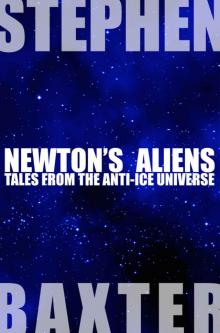 Newton's Aliens: Tales From the Anti-Ice Universe
Newton's Aliens: Tales From the Anti-Ice Universe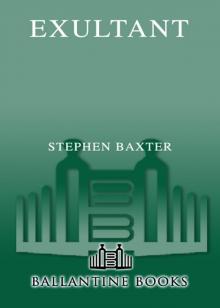 Exultant
Exultant Manifold: Origin
Manifold: Origin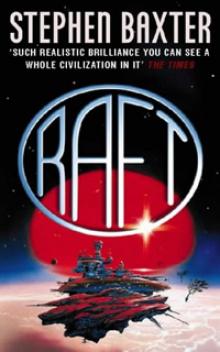 Raft xs-1
Raft xs-1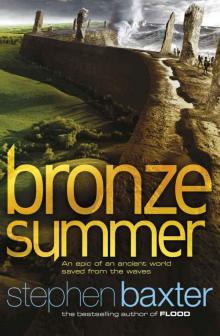 Bronze Summer n-2
Bronze Summer n-2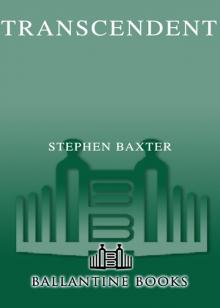 Transcendent
Transcendent Stone Spring
Stone Spring Coalescent
Coalescent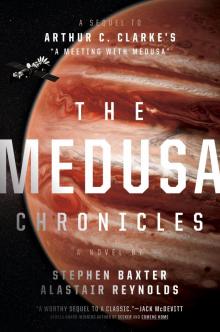 The Medusa Chronicles
The Medusa Chronicles Origin m-3
Origin m-3 Silverhair tm-1
Silverhair tm-1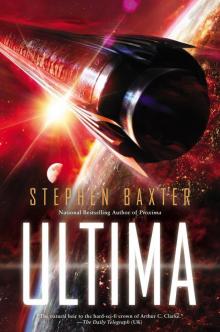 Ultima
Ultima Voyage n-1
Voyage n-1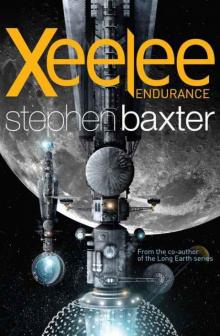 Xeelee: Endurance
Xeelee: Endurance Space m-2
Space m-2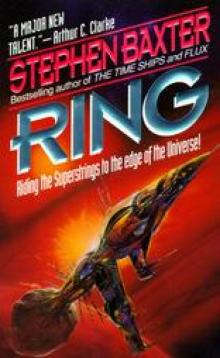 Ring xs-4
Ring xs-4 Raft
Raft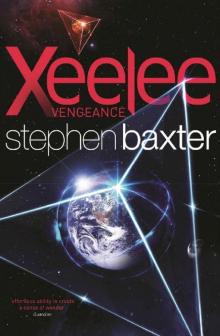 Xeelee: Vengeance
Xeelee: Vengeance Iron Winter n-3
Iron Winter n-3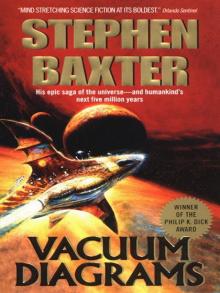 Vacuum Diagrams
Vacuum Diagrams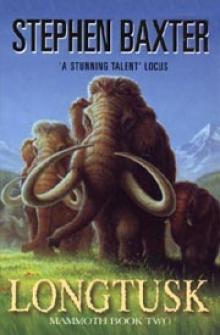 Longtusk tm-2
Longtusk tm-2 Proxima
Proxima Evolution
Evolution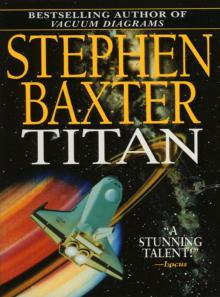 Titan
Titan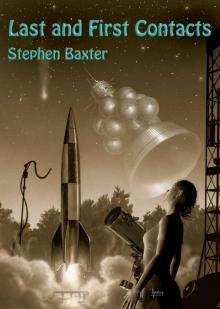 Last and First Contacts (Imaginings)
Last and First Contacts (Imaginings) Emperor
Emperor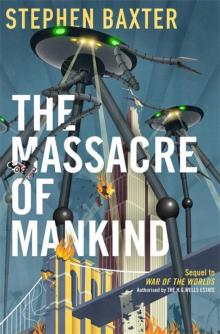 The Massacre of Mankind
The Massacre of Mankind Starfall
Starfall Doctor Who - The Wheel of Ice
Doctor Who - The Wheel of Ice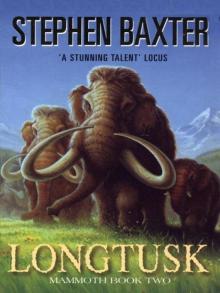 Longtusk
Longtusk Silverhair
Silverhair Conqueror tt-2
Conqueror tt-2 Flood
Flood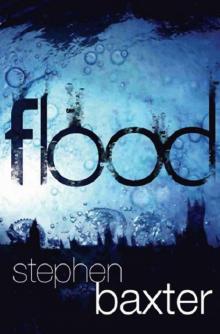 Flood f-1
Flood f-1 Emperor tt-1
Emperor tt-1 Moonseed
Moonseed Conqueror
Conqueror Timelike Infinity xs-2
Timelike Infinity xs-2 The Ghost Pit
The Ghost Pit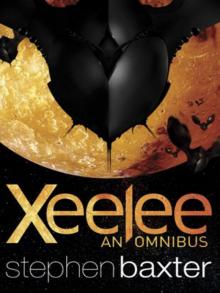 Xeelee: An Omnibus: Raft, Timelike Infinity, Flux, Ring
Xeelee: An Omnibus: Raft, Timelike Infinity, Flux, Ring Weaver tt-4
Weaver tt-4 Landfall: Tales From the Flood/Ark Universe
Landfall: Tales From the Flood/Ark Universe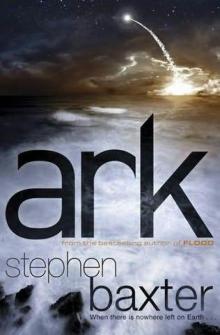 Ark
Ark Emperor: Time’s Tapestry Book One
Emperor: Time’s Tapestry Book One Space
Space Icebones
Icebones Manifold: Space
Manifold: Space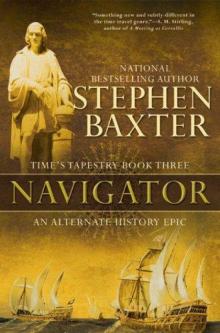 Navigator
Navigator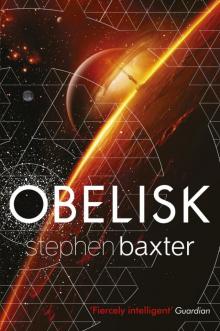 Obelisk
Obelisk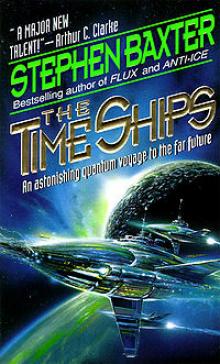 The Time Ships
The Time Ships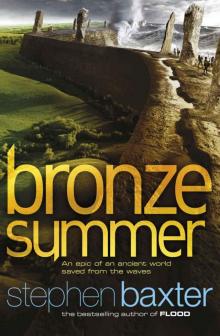 Bronze Summer
Bronze Summer Resplendent
Resplendent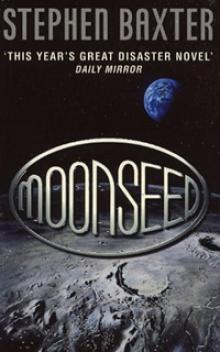 Moonseed n-3
Moonseed n-3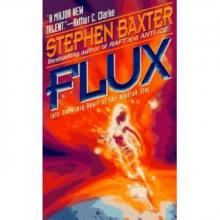 Flux xs-3
Flux xs-3 Transcendent dc-3
Transcendent dc-3 Icebones tm-3
Icebones tm-3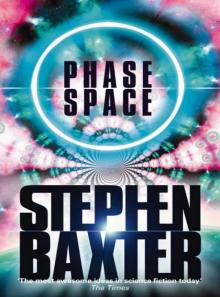 Phase Space
Phase Space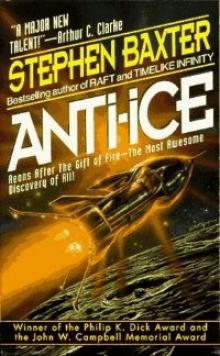 Anti-Ice
Anti-Ice Weaver
Weaver Voyage
Voyage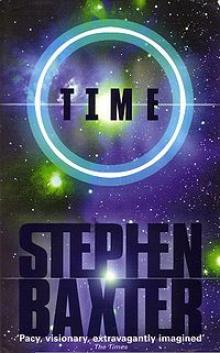 Time m-1
Time m-1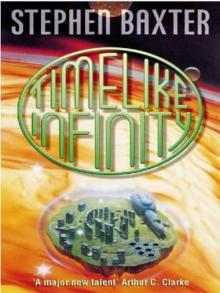 Timelike Infinity
Timelike Infinity Exultant dc-2
Exultant dc-2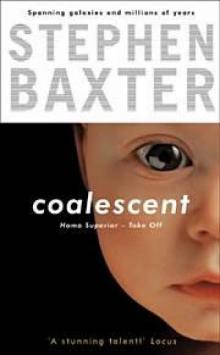 Coalescent dc-1
Coalescent dc-1 Navigator tt-3
Navigator tt-3